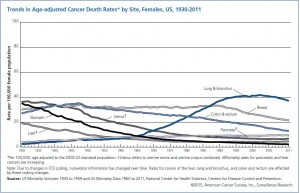Under Obamacare, Will America Keep Winning the War on Cancer?
A similar version of this Health Alert was posted at Forbes.
The American Cancer Society (ACS) has just released its annual Cancer Facts and Figures. The announcement describes how successful the war on cancer has been:
Annual statistics reporting from the American Cancer Society shows the death rate from cancer in the US has fallen 22% from its peak in 1991. This translates to more than 1.5 million deaths from cancer that were avoided.
There are a number of explanations for this success. The most important appears to be the reduction in smoking in the population. Lung cancer is still very deadly. However, because fewer people are diagnosed, the death rate from lung cancer has dropped dramatically since the early 1990s for men and turned around for women starting about 2005.
As shown in the two graphs below, deaths from lung cancer had actually increased dramatically for men since the 1930s and for women since the 1960s, so a reduction is a welcome break in the trend. Still, almost one in three cancer deaths in the United States in 2015 will be due to smoking.
For other cancers, however, improvements in diagnosis and treatment are largely responsible for the improved outcomes. The five-year relative survival rate for all cancers diagnosed from 2004-2010 was 68 percent, up from 49 percent for 1975-1977. This is the number of people diagnosed who survive for five years divided by the total number diagnosed.
Critics like Ezra Klein disapprove of this measure, noting that more frequent testing will lead to earlier diagnosis of cancer which may not ever kill the patient, so will artificially improve survival rates. A better measure, according to Mr. Klein, is the death rate, which is simply the ratio of cancer deaths to the number of people in the country. The ACS report answers that convincingly:
Death rates for breast cancer are down more than one-third (35%) from peak rates, while prostate and colon cancer death rates are each down by nearly half (47%) as a result of improvements in early detection and treatments.
Two of those three, breast cancer and prostate cancer, are often identified as “over-diagnosed” and “over-treated” in America. The evidence of the last two decades tell us we should be wary of policies that would swing the pendulum back to under-diagnosed and under-treated.
The death rate from prostate cancer has dropped from 40 per 100,000 men in the early 1990s to half of that in 2011. For women, breast cancer deaths peaked at about 30 per 100,000 in 1990 and dropped to about 20 in 2011.
Comparing the improvements in the five-year survival rate across different types of cancer also suggests that those who claim over-diagnosis is responsible for improvement in prostate or breast cancer survival may be stretching their case. Over the two periods, 1975-1977 and 2004-2010, the survival rate for prostate cancer increased from 68 percent to over 99 percent, an improvement of almost half, and the survival rate for breast cancer improved from 75 percent to 91 percent, an improvement of one-fifth.
However, the survival rate for lung cancer increased from 12 percent to 18 percent, an improvement of half. For stomach cancer, the improvement was from 15 percent to 29 percent, almost double. For cancer of the pancreas, the improvement was from 3 percent to 7 percent, more than double. Critics have not asserted over-diagnosis of lung or stomach or pancreatic cancer during those years.
In light of this success, Americans should be wary of overly optimistic promises to change our health coverage dramatically, which could threaten future successes in the war on cancer. Obamacare brings about such change. Unfortunately, the ACS sees only good outcomes from Obamacare, cheering that it will increase the number of insured people.
However, most of Obamacare’s newly insured will be dependent on Medicaid, where breast-cancer patients have worse health outcomes than privately insured patients. As for those on Obamacare’s health insurance exchanges, Avalere, a healthcare consulting practice, has published a series of papers analyzing prescription coverage in those plans. The latest concludes that they have complicated, multiple tiers of co-pays and co-insurance for specialty drugs, including cancer drugs:
“Consumers purchasing these plans need to understand what’s in their benefit plan and be ready for a substantial out-of-pocket costs if specialty products are needed,” said Dan Mendelson, CEO of Avalere, “While these plans are typical of the exchanges and Medicare Part D where insurers are competing to keep premiums low, they remain rare in the employer market.”
America cannot continue to win the war on cancer if Obamacare succeeds in reducing Americans’ access to oncologists or cancer drugs.



Rationed care, as will be the only way Obamacare can work, will lose the battle against all diseases.
And with the many High Deductible plans, people will put off going to the doctor, leaving undiagnosed and untreated many insidious illness like cancer. But maybe that old lady can just take a pain pill and be allowed to fade away without treating her costly cancer, as some official who shall remain nameless but rhymes with arack beau bama once said.
Well said, Big Truck Joe. Many studies have shown that high out-of-pocket costs lead to the foregoing/delay of diagnosis, treatment and even childbirth.
Out of pocket costs lead to delaying childbirth? That would seem to violate the laws of biology!
Jake,
In the long run we are all dead.